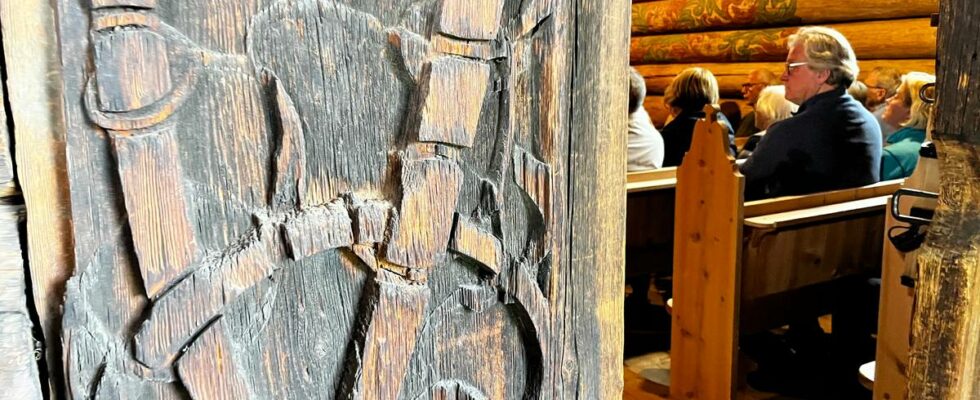The case in summary: New investigations of wood carvings at the Bjølstad chapel in Heidal in Gudbrandsdalen have provided new insight into the urn style, a Norse style of art. Samples of two portal planks from the church show that they are from different times, with the oldest from around 1014, while the youngest was probably carved in the late 13th century. This may indicate that the urns style has been in use longer than previously thought. The National Antiquarian says that this is completely new knowledge, and that it may lead to us having to rewrite our history. There are still many unanswered questions, and there will now be more research in the area. The summary is made by an AI service from OpenAI. The content is quality assured by news’s journalists before publication. – These samples really surprise us, says Riksantikvar Hanna Geiran. The samples she is talking about are from the church portal of the Bjølstad Chapel in Heidal in Gudbrandsdalen. The church, which dates from around 1530, is decorated with two portal planks on each side of the entrance door. The portal pillars of the church are in urn style. It has long been known that these are old, among the oldest carved wood in the country. Photo: Even Lusæter / news These are in the so-called urn style, a Norse style of art named after Urnes Stavkyrkje in Luster, which is recognized as having the oldest preserved decorations in this style. The urn style, which is characterized by its characteristic animal motifs, has had a great influence on both Norwegian and European art. Art historians call this the last Viking style. What exists of objects in Scandinavia and the British Isles in this style is from the middle of the 11th century and some way into the 12th century. But now it seems that the style did not die out in the 12th century after all. – It may look as if the urn style has been in use longer than we thought. This is completely new knowledge, says Geiran. Riksantikvar Hanna Geiran says that the research that has been done of the portal planks can change the history of Norway. Photo: Even Lusæter / news Difference over a hundred years For the samples from the portal planks of the Bjølstad Chapel, show that they are from completely different times. The dating shows that the oldest plank, the one to the right of the door, comes from a tree that began to sprout around the year 880, and was cut down in 1014. The other plank is over 150 years older, and was probably cut out well into the 13th century . – I am not aware of anything with urn decoration from well into the 13th century, says section head Ingeborg Magerøy for the church section at the National Archives. – What on earth has happened in Heidal, wonders Magerøy. Photo: Riksantikvaren Now both the Riksantikvaren and the village are left with more questions than answers. Was the first portal plank copied? Why did they cut out the plank in what was long ago an old-fashioned style in the 13th century? Or did the urn style live longer than people thought? – We need to do more research on this. Now we have scanned the planks, and by looking at traces of craftsmanship, it can give us more answers to the mystery, says Geiran. More questions than answers When they started examining the planks, they had one question: How old is the portal? – For years there has been speculation as to how old they are. It has been said that it is one of the oldest, and perhaps the very oldest, says the parish priest in Sel, Steinar Grønn. Steinar Løsneløkken and Steinar Grønn had hoped to find out exactly when the portal to the church is from. But the survey raised more questions than answers. Photo: Even Lusæter / news Using year-ring dating and carbon analysis, they have found that the oldest plank from the Bjølstad chapel is from after the year 1014. – It is clear that there are not two lines under the answer, so here we have a puzzle to solve, says Steinar Løsneløkken, leader of the Sel church council. – There are probably not that many pieces of wood in the country that are older than this, I think, he says. The oldest portal in Norway is the Urneportalen from between 1050 and 1200. But that the portal from Heidal is older than that cannot be said for sure yet. – We cannot say that it is the oldest, but we can say that it is one of the most mysterious, says Magerøy. The Bjølstad Chapel in Heidal is a lean-to church building from the Middle Ages with urn-style portal pillars. The chapel is on the National Archives’ list of automatically protected churches. Photo: Even Lusæter / news A mystery Even if the investigations gave more questions than answers, the National Antiquary is clear about one thing. – They have got a real mystery in Heidal now. – Now we hope to find this out, and maybe we have to write about our history, says Geiran. Published 29/08/2024, at 16.38
ttn-69
– What in the world has happened? – news Innlandet – Local news, TV and radio

